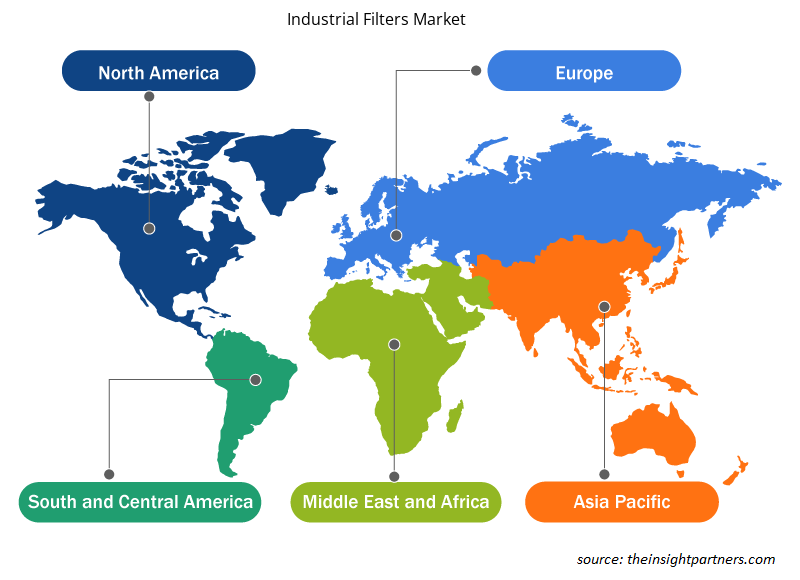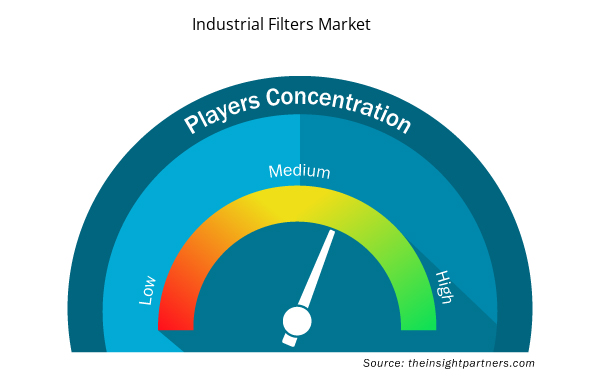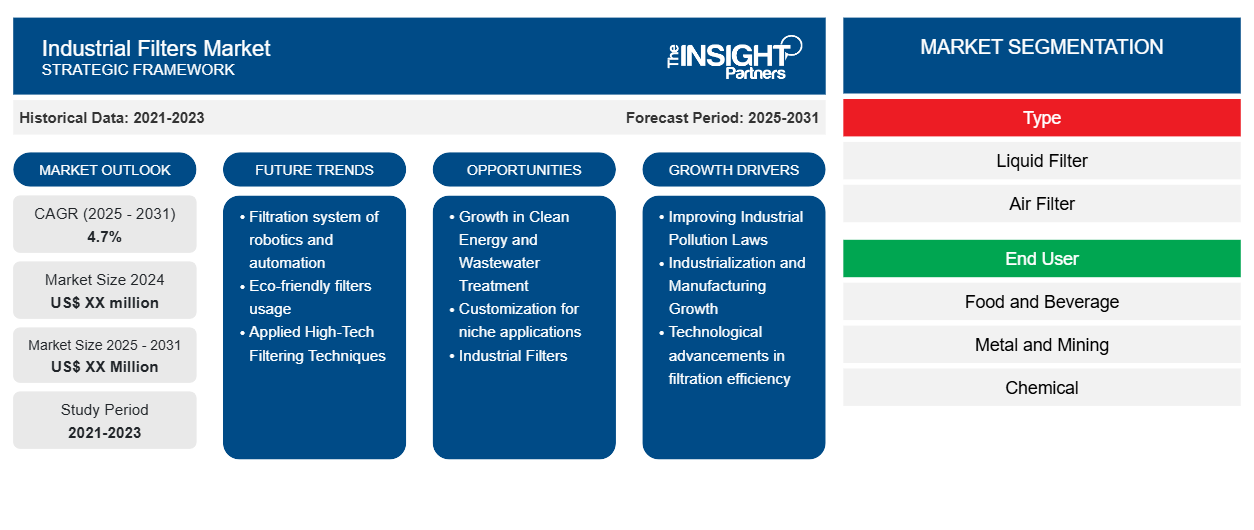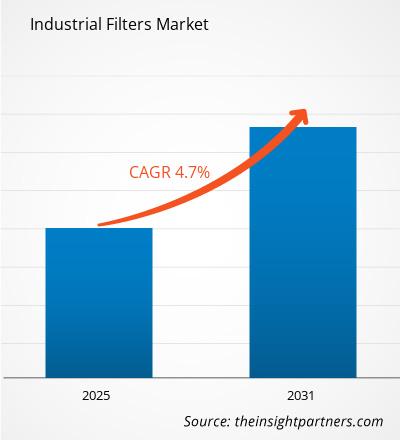Si prevede che il mercato dei filtri industriali registrerà un CAGR del 4,7% dal 2023 al 2031, con una dimensione di mercato in espansione da XX milioni di dollari nel 2023 a XX milioni di dollari entro il 2031.
Il rapporto di mercato sui filtri industriali è suddiviso per tipo di prodotto nei seguenti sottosegmenti: filtri liquidi, filtri aria e altri. È inoltre suddiviso per utente finale, tra cui alimenti e bevande, metalli e mineraria, prodotti chimici, farmaceutici, produzione di energia e altri. L'analisi globale è suddivisa a livello regionale e per paesi principali. La valutazione del mercato è presentata in dollari USA per l'analisi segmentale di cui sopra, con proiezioni fino al 2031.
Scopo del rapporto
Il report Industrial Filters Market di The Insight Partners mira a descrivere il panorama attuale e la crescita futura, i principali fattori trainanti, le sfide e le opportunità. Ciò fornirà spunti a vari stakeholder aziendali, come:
- Fornitori/produttori di tecnologia: per comprendere le dinamiche di mercato in evoluzione e conoscere le potenziali opportunità di crescita, consentendo loro di prendere decisioni strategiche informate.
- Investitori: condurre un'analisi completa delle tendenze in merito al tasso di crescita del mercato, alle proiezioni finanziarie del mercato e alle opportunità esistenti lungo la catena del valore.
- Enti di regolamentazione: regolamentano le politiche e le attività di controllo sul mercato allo scopo di ridurre al minimo gli abusi, preservare la fiducia degli investitori e sostenere l'integrità e la stabilità del mercato.
Segmentazione del mercato dei filtri industriali
Tipo
- Filtro liquido
- Filtro dell'aria
Utente finale
- Cibo e bevande
- Metallo e estrazione mineraria
- Chimico
- Farmaceutico
- Produzione di energia
- Altri
Personalizza questo report in base alle tue esigenze
Riceverai la personalizzazione gratuita di qualsiasi report, comprese parti di questo report, o analisi a livello nazionale, pacchetto dati Excel, oltre a usufruire di grandi offerte e sconti per start-up e università
- Scopri le principali tendenze di mercato in questo rapporto.Questo campione GRATUITO includerà analisi di dati che spaziano dalle tendenze di mercato alle stime e alle previsioni.
Driver di crescita del mercato dei filtri industriali
- Miglioramento delle leggi sull'inquinamento industriale: le severe leggi ambientali nei settori dell'inquinamento dell'aria e dell'acqua stanno costringendo le industrie a investire in tecnologie di filtrazione efficaci.
- Crescita dell'industrializzazione e della produzione: la crescita dei settori manifatturiero e industriale nei mercati emergenti comporta un aumento della domanda di soluzioni di filtrazione, poiché è necessario preservare la qualità dell'aria e dell'acqua.
- Progressi tecnologici nell'efficienza di filtrazione: le innovazioni nei nuovi materiali e nella progettazione dei filtri migliorano l'efficienza e il ciclo di vita dei filtri industriali, rendendoli così convenienti.
Tendenze future del mercato dei filtri industriali
- Sistema di filtrazione della robotica e dell'automazione: l'integrazione di IoT e AI inizierà a monitorare e controllare i sistemi di filtrazione in tempo reale e, quindi, farà parte della tendenza in evoluzione poiché aumenta l'efficienza del sistema e riduce le possibilità di perdita di tempo.
- Utilizzo di filtri ecologici: con la crescente consapevolezza ambientale, si tende a utilizzare materiali ecologici e biodegradabili per realizzare i filtri, riducendo così gli sprechi e preservando la sostenibilità.
- Tecniche di filtraggio ad alta tecnologia applicate: con una sempre maggiore implementazione, i filtri in nanofibre e i precipitanti elettrostatici sono ampiamente utilizzati nell'industria che opera con rigorosi standard di qualità dell'aria.
Opportunità di mercato dei filtri industriali
- Crescita nei settori dell'energia pulita e del trattamento delle acque reflue: poiché si registra una crescita nei settori dell'energia pulita e del trattamento delle acque reflue, aumenterà la domanda di filtri industriali per migliorare la qualità dell'aria e dell'acqua nei settori dell'energia pulita e del trattamento delle acque.
- Personalizzazione per applicazioni di nicchia: in applicazioni di nicchia come i settori farmaceutico, alimentare e delle bevande e petrolchimico, esistono opportunità attraverso soluzioni di filtrazione personalizzate.
- Filtri industriali: i filtri intelligenti abilitati all'integrazione IoT offrono un'opportunità Lo sviluppo di filtri industriali si baserebbe sull'abilitazione IoT, che facilita il monitoraggio in tempo reale e consente la manutenzione predittiva.
Approfondimenti regionali sul mercato dei filtri industriali
Le tendenze regionali e i fattori che influenzano il mercato dei filtri industriali durante il periodo di previsione sono stati ampiamente spiegati dagli analisti di Insight Partners. Questa sezione discute anche i segmenti e la geografia del mercato dei filtri industriali in Nord America, Europa, Asia Pacifico, Medio Oriente e Africa e America meridionale e centrale.

- Ottieni i dati specifici regionali per il mercato dei filtri industriali
Ambito del rapporto di mercato sui filtri industriali
| Attributo del report | Dettagli |
|---|---|
| Dimensioni del mercato nel 2023 | XX milioni di dollari USA |
| Dimensioni del mercato entro il 2031 | XX milioni di dollari USA |
| CAGR globale (2023-2031) | 4,7% |
| Dati storici | 2021-2022 |
| Periodo di previsione | 2024-2031 |
| Segmenti coperti | Per tipo
|
| Regioni e Paesi coperti | America del Nord
|
| Leader di mercato e profili aziendali chiave |
|
Densità degli attori del mercato dei filtri industriali: comprendere il suo impatto sulle dinamiche aziendali
Il mercato dei filtri industriali sta crescendo rapidamente, spinto dalla crescente domanda degli utenti finali dovuta a fattori quali l'evoluzione delle preferenze dei consumatori, i progressi tecnologici e una maggiore consapevolezza dei vantaggi del prodotto. Con l'aumento della domanda, le aziende stanno ampliando le loro offerte, innovando per soddisfare le esigenze dei consumatori e capitalizzando sulle tendenze emergenti, il che alimenta ulteriormente la crescita del mercato.
La densità degli operatori di mercato si riferisce alla distribuzione di aziende o società che operano in un particolare mercato o settore. Indica quanti concorrenti (operatori di mercato) sono presenti in un dato spazio di mercato in relazione alle sue dimensioni o al valore di mercato totale.
Le principali aziende che operano nel mercato dei filtri industriali sono:
- 3 milioni
- Ahlstrom-Munksjo
- Gruppo di filtrazione Clear Edge
- Tessuto non tessuto Fibertex
Disclaimer : le aziende elencate sopra non sono classificate secondo un ordine particolare.

- Ottieni una panoramica dei principali attori del mercato dei filtri industriali
Punti chiave di vendita
- Copertura completa: il rapporto copre in modo completo l'analisi di prodotti, servizi, tipologie e utenti finali del mercato dei filtri industriali, fornendo una panoramica olistica.
- Analisi degli esperti: il rapporto è compilato sulla base della conoscenza approfondita di esperti e analisti del settore.
- Informazioni aggiornate: il rapporto garantisce la pertinenza aziendale grazie alla copertura di informazioni recenti e tendenze nei dati.
- Opzioni di personalizzazione: questo report può essere personalizzato per soddisfare le esigenze specifiche del cliente e adattarsi in modo appropriato alle strategie aziendali.
Il rapporto di ricerca sul mercato dei filtri industriali può quindi aiutare a guidare il percorso di decodifica e comprensione dello scenario del settore e delle prospettive di crescita. Sebbene possano esserci alcune preoccupazioni valide, i vantaggi complessivi di questo rapporto tendono a superare gli svantaggi.
- Analisi storica (2 anni), anno base, previsione (7 anni) con CAGR
- Analisi PEST e SWOT
- Valore/volume delle dimensioni del mercato - Globale, regionale, nazionale
- Industria e panorama competitivo
- Set di dati Excel



Report Coverage
Revenue forecast, Company Analysis, Industry landscape, Growth factors, and Trends

Segment Covered
This text is related
to segments covered.

Regional Scope
North America, Europe, Asia Pacific, Middle East & Africa, South & Central America

Country Scope
This text is related
to country scope.
Domande frequenti
3M, Ahlstrom-Munksjo, Clear Edge Filtration Group, Fibertex Nonwoven, Freudenberg Filtration Technologies, Lydall Inc., Nordic Air Filtration, Sandler AG, Sefar AG, Valmet Corporation are the leading ones in this Industrial Filters Market.,
The report can be delivered in PDF/PPT format; we can also share excel dataset based on the request.
Some of the customization options available based on request are additional 3-5 company profiles and country-specific analysis of 3-5 countries of your choice. Customizations are to be requested/discussed before making final order confirmation, as our team would review the same and check the feasibility.
The market is expected to register a CAGR of 4.7% during 2023-2031.
The driving factors of the market are demand for cleaner air and water, stringent environment laws, and high-efficiency filtration systems.
Future trends would include development of smart filtration systems with IoT integrated into them for online monitoring and maintenance. The filters are to be increasingly of sustainable and recyclable materials, and nanotechnology is expected to be an area of continued innovation to enhance the efficiency of filters, particularly in applications involving air and water purification.
Trends and growth analysis reports related to Manufacturing and Construction : READ MORE..
The List of Companies
1. 3M
2. Ahlstrom-Munksjo
3. Clear Edge Filtration Group
4. Fibertex Nonwoven
5. Freudenberg Filtration Technologies
6. Lydall Inc.
7. Nordic Air Filtration
8. Sandler AG
9. Sefar AG
10. Valmet Corporation
The Insight Partners performs research in 4 major stages: Data Collection & Secondary Research, Primary Research, Data Analysis and Data Triangulation & Final Review.
- Data Collection and Secondary Research:
As a market research and consulting firm operating from a decade, we have published and advised several client across the globe. First step for any study will start with an assessment of currently available data and insights from existing reports. Further, historical and current market information is collected from Investor Presentations, Annual Reports, SEC Filings, etc., and other information related to company’s performance and market positioning are gathered from Paid Databases (Factiva, Hoovers, and Reuters) and various other publications available in public domain.
Several associations trade associates, technical forums, institutes, societies and organization are accessed to gain technical as well as market related insights through their publications such as research papers, blogs and press releases related to the studies are referred to get cues about the market. Further, white papers, journals, magazines, and other news articles published in last 3 years are scrutinized and analyzed to understand the current market trends.
- Primary Research:
The primarily interview analysis comprise of data obtained from industry participants interview and answers to survey questions gathered by in-house primary team.
For primary research, interviews are conducted with industry experts/CEOs/Marketing Managers/VPs/Subject Matter Experts from both demand and supply side to get a 360-degree view of the market. The primary team conducts several interviews based on the complexity of the markets to understand the various market trends and dynamics which makes research more credible and precise.
A typical research interview fulfils the following functions:
- Provides first-hand information on the market size, market trends, growth trends, competitive landscape, and outlook
- Validates and strengthens in-house secondary research findings
- Develops the analysis team’s expertise and market understanding
Primary research involves email interactions and telephone interviews for each market, category, segment, and sub-segment across geographies. The participants who typically take part in such a process include, but are not limited to:
- Industry participants: VPs, business development managers, market intelligence managers and national sales managers
- Outside experts: Valuation experts, research analysts and key opinion leaders specializing in the electronics and semiconductor industry.
Below is the breakup of our primary respondents by company, designation, and region:

Once we receive the confirmation from primary research sources or primary respondents, we finalize the base year market estimation and forecast the data as per the macroeconomic and microeconomic factors assessed during data collection.
- Data Analysis:
Once data is validated through both secondary as well as primary respondents, we finalize the market estimations by hypothesis formulation and factor analysis at regional and country level.
- Macro-Economic Factor Analysis:
We analyse macroeconomic indicators such the gross domestic product (GDP), increase in the demand for goods and services across industries, technological advancement, regional economic growth, governmental policies, the influence of COVID-19, PEST analysis, and other aspects. This analysis aids in setting benchmarks for various nations/regions and approximating market splits. Additionally, the general trend of the aforementioned components aid in determining the market's development possibilities.
- Country Level Data:
Various factors that are especially aligned to the country are taken into account to determine the market size for a certain area and country, including the presence of vendors, such as headquarters and offices, the country's GDP, demand patterns, and industry growth. To comprehend the market dynamics for the nation, a number of growth variables, inhibitors, application areas, and current market trends are researched. The aforementioned elements aid in determining the country's overall market's growth potential.
- Company Profile:
The “Table of Contents” is formulated by listing and analyzing more than 25 - 30 companies operating in the market ecosystem across geographies. However, we profile only 10 companies as a standard practice in our syndicate reports. These 10 companies comprise leading, emerging, and regional players. Nonetheless, our analysis is not restricted to the 10 listed companies, we also analyze other companies present in the market to develop a holistic view and understand the prevailing trends. The “Company Profiles” section in the report covers key facts, business description, products & services, financial information, SWOT analysis, and key developments. The financial information presented is extracted from the annual reports and official documents of the publicly listed companies. Upon collecting the information for the sections of respective companies, we verify them via various primary sources and then compile the data in respective company profiles. The company level information helps us in deriving the base number as well as in forecasting the market size.
- Developing Base Number:
Aggregation of sales statistics (2020-2022) and macro-economic factor, and other secondary and primary research insights are utilized to arrive at base number and related market shares for 2022. The data gaps are identified in this step and relevant market data is analyzed, collected from paid primary interviews or databases. On finalizing the base year market size, forecasts are developed on the basis of macro-economic, industry and market growth factors and company level analysis.
- Data Triangulation and Final Review:
The market findings and base year market size calculations are validated from supply as well as demand side. Demand side validations are based on macro-economic factor analysis and benchmarks for respective regions and countries. In case of supply side validations, revenues of major companies are estimated (in case not available) based on industry benchmark, approximate number of employees, product portfolio, and primary interviews revenues are gathered. Further revenue from target product/service segment is assessed to avoid overshooting of market statistics. In case of heavy deviations between supply and demand side values, all thes steps are repeated to achieve synchronization.
We follow an iterative model, wherein we share our research findings with Subject Matter Experts (SME’s) and Key Opinion Leaders (KOLs) until consensus view of the market is not formulated – this model negates any drastic deviation in the opinions of experts. Only validated and universally acceptable research findings are quoted in our reports.
We have important check points that we use to validate our research findings – which we call – data triangulation, where we validate the information, we generate from secondary sources with primary interviews and then we re-validate with our internal data bases and Subject matter experts. This comprehensive model enables us to deliver high quality, reliable data in shortest possible time.


 Ottieni un campione gratuito per questo repot
Ottieni un campione gratuito per questo repot